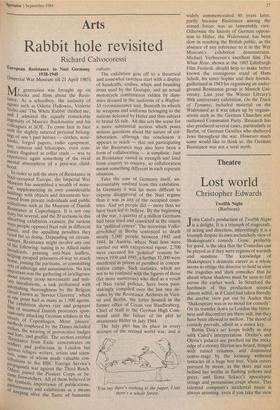Arts
Rabbit hole revisited
Richard Calvocoressi
European Resistance to. Nazi Germany 1938-1945
(Imperial War Museum till 21 April 1985) My generation was brought up on books and films about the Resis- Lime. As a schoolboy, the audacity of agents such as Odette Hallowes, Violette - Szabo and 'The White Rabbit' thrilled me, and I admired the equally remarkable Ingenuity of Maurice Buckmaster and his colleagues at SOE. To come face to face with the slightly tattered personal belong- ings of one's past heroes — clothes, note- u.00ks, forged papers, radio equipment, tiny cameras and telescopes, even com- Passes disguised as collar studs — was to experience again something of the vivid Mental atmosphere of a post-war child- hood.
In order to tell the story of Resistance in Nazi-occupied Europe, the Imperial War hluseum has assembled a wealth of mate- rial, supplementing its own considerable holdings with objects and documents bor- rowed from private individuals and public ollections such as the Museum of Danish rcesistance at Copenhagen. It is not one story but several, and the 20 sections in this absorbing exhibition examine the various Ways people opposed Nazi rule in different Places, and the appalling penalties they Need for so doing. Depending on circum- stances, Resistance might involve any one F4 the following: tuning in to Allied radio bproadcasts, printing anti-Nazi leaflets, Ping escaped prisoners-of-war to reach °me, joining the partisans, or committing at of sabotage and assassination. No less nnPortant was the gathering of intelligence L,about enemy troop movements and .mili- arY Installations, a task performed with a-stnnishing thoroughness by the Belgian circuit known as 'Service Clarence', which ,a/t,rme point had as many as 1,500 agents. it f :le exhibition shows rare and poignant tamunarmed Danish protesters spon- :.fleclusly attacking German soldiers in the dre •-• of Copenhagen. More. 'passive' IeIb sTtlethods employed by the Danes included ,P.kes, the wearing of provocative badges oa hats' and graffiti. The section entitled Res. 'stance from Exile' concentrates on Soldiers and politicians in London but i!Pores refugee writers, artists and scien- tirs.ts, Some of whom made valuable con- _ri43b "utions to the BBC Foreign Service's ti),„Paganda war against the Third Reich. v_atuers. joined the Pioneer Corps or be- th_Ine firewatchers. All of them believed in symbolic importance of publications, lairIormances and exhibitions as a means keePing alive the flame of humanist
culture.
The exhibition gets off to a theatrical and somewhat tasteless start with a display of handcuffs, coshes, whips and branding irons used by the Gestapo, and an actual motorcycle combination ridden by dum- mies dressed in the uniforms of a Waffen- SS reconnaissance unit. Beneath its wheels lie weapons and uniforms belonging to the nations defeated by Hitler and thus subject to brutal SS rule. All this sets the scene for a more substantial section which poses serious questions about the nature of col- laboration, although the conclusion it appears to reach — that not participating in the Resistance may also have been a form of collaboration — is simplistic. Just as Resistance varied in strength and kind from country to country, so collaboration meant something different in each separate situation.
Take the case of Germany itself, un- accountably omitted from this exhibition. In Germany it was far more difficult to express disapproval of the Nazi regime than it was in any of the occupied coun- tries. And yet people did — more than we have been led to believe. By the beginning of the war, a quarter of a million Germans had been tried and convicted in the courts for 'political crimes'. The notorious Volks- gerichthof in Berlin sentenced to death nearly 5,000 people between 1942 and 1944. In Austria, where Nazi laws were carried out with exceptional rigour, 2,700 were executed for 'political' reasons be- tween 1938 and 1945; a further 32,000 were murdered in prison or perished in concen- tration camps. Such statistics, which are not to be confused with the figures of those (far more numerous) who died as a result of Nazi racial policies, have been pain- stakingly compiled over the last two de- cades by the Resistance Archives in Vien- na and Berlin, the latter .housed in the former office of Count von Stauffenberg, Chief of Staff to the German High Com- mand until the failure of his plot to assassinate Hitler in July 1944.
The July plot has its place in every account of the second world war, and is
'You say there's nothing in the paper; I say there's a whole forest.'
widely commemorated 40 years later, partly because Resistance among the armed forces was so lamentably rare. Otherwise the history of German opposi- tion to Hitler, the Widerstand, has been slow in reaching the British public, as the absence of any reference to it in the War Museum's exhibition demonstrates. Michael Verhoeven's excellent film The White Rose, shown at the 1983 Edinburgh Film Festival, should help to make better known the courageous stand of Hans Scholl, his sister Sophie and their friends, guillotined in 1943 for organising an under- ground Resistance group at Munich Uni- versity. Last year the Wiener Library's 50th anniversary exhibition, On the Track of Tyranny, included material on the Widerstand as it was taken up by organis- ations such as the German Churches and outlawed Communist Party. Research has also produced several cases, particularly in Berlin, of German Gentiles who sheltered Jews throughout the war. However much some would like to think so, the German Resistance was not a total myth.










































 Previous page
Previous page